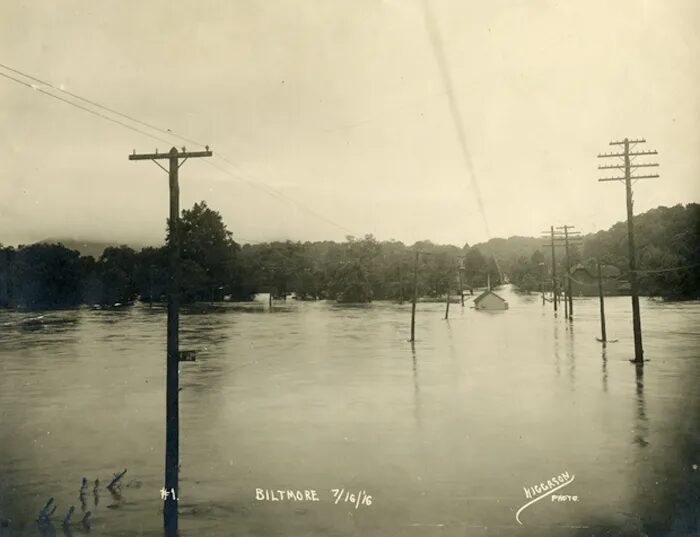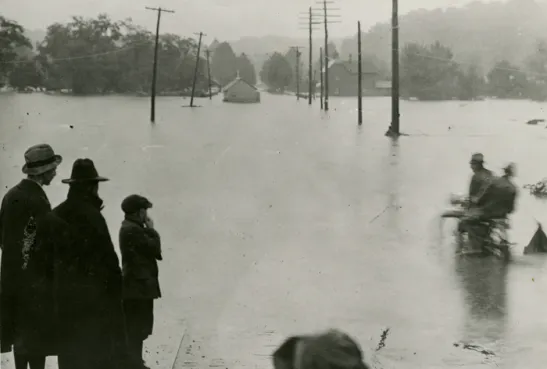My parents, James Cornelius and Sarah Annabella Clark Lipe, from Mooresville, NC, were among the first residents of Biltmore Village. Our two-story home had a wide front porch, shaded by vines in summer, and stood on the banks of the Swannanoa River near the old iron bridge that led to Asheville.
The most memorable event of my life in Biltmore occurred three weeks before my 18th birthday, on July 16, 1916, when the Swannanoa overflowed its banks. Papa, knowing the foundations of our home on the riverbank to be strong, did not expect trouble, but Mama took Nell, my crippled sister, and my Grandmother Clark to stay with friends on higher ground.
Before dawn on the 16th, my sister, Bess, and I found Papa securing some chickens and turkeys on the front porch. Already, sightseers from the village were wading near the house to view the swollen river. With Papa, we joined a group of forestry students and young people heading into the village. To my surprise, as we crossed the train tracks, the water became deeper, the current more swift. Our group held hands, keeping our backs to the current, and struck out across the Village Green, hoping to reach high ground beyond the lodge gate to the Biltmore Estate. By the time we reached Lodge Street, the water was almost over our heads. Torrents from broken dams upriver had changed the course of the Swannanoa. We were caught in the middle of a wide, wild river.
Some of the men swam to safety. Bess, who had waded ahead, spent the day on a pile of jammed lumber, praying it wouldn’t be swept away. Though a good swimmer, Papa helped me and three young women to grab hold of a large tree near the lodge gate. Both Vickie Foister and Charlotte Walker were nurses at the hospital; Marion Walker was only 15. None of us were strong enough to shinny up to safety in the branches far overhead. We stretched my sweater around the trunk to hold to, moving it up as the cold water rose. Papa positioned himself behind me so that I was cradled in his arms.
Crowds lined the shore to watch as life guards attempted to rescue us through the swift current. Men in canoes and on horseback failed. Papa kept saying, ‘If only they would get a flat-bottomed boat!’ Our struggle to keep from being swept away by the swift, cold current was exhausting us.
At last, when a life guard reached us, we insisted he take back Marion, the youngest. Though she agreed to go, on the way back Marion panicked, fought her rescuer, and drowned. Charlotte, her sister, became hysterical, crying, ‘Marion! Marion!’ and shortly she dropped off the tree.
I lost track of time. Hours must have passed before I felt Papa’s arms leave me. As he struggled to grab at the next tree, I wondered if he had had a cramp. Then I heard his familiar, ‘Shucks! Shucks!’ as he was swept away. Photo above on right is a current photograph of the railroad bridge that crosses the Swannanoa River in Biltmore located approximately fifty yards below where the Lipe house was located.
Vickie Foister gave no cry when she let go. I was praying for the strength to hang on when I missed her. Alone, I continued to pray, hoping that Papa and the girls had managed to grab another tree.
Out of nowhere, a man reached the tree where I clung and climbed into its branches. When I begged for his help to climb up, he explained that, as a father and husband, he could not take the risk. Instead, he let down a branch, offering to pull me up. Exhausted, as soon as I was raised from the water, I fell back. Frantically, I grabbed for the tree again. Now my sweater was gone. My inner thighs, gripping the rough bark, were raw. I wondered how much longer I could last.
Suddenly, I saw a life guard swimming toward me with a rope. When he reached me, he tied me to the tree. Then I knew my life had been saved.
Sometime in the afternoon, about eight or nine hours after I had left home, men reached the tree in a flat-bottomed boat. Only after I had spent several days in the hospital was I told that my father, Vickie, and Charlotte had drowned.
Our home stood until the water subsided, then collapsed into the Swannanoa.
– Kathleen Lipe Carter (1898-1989)


